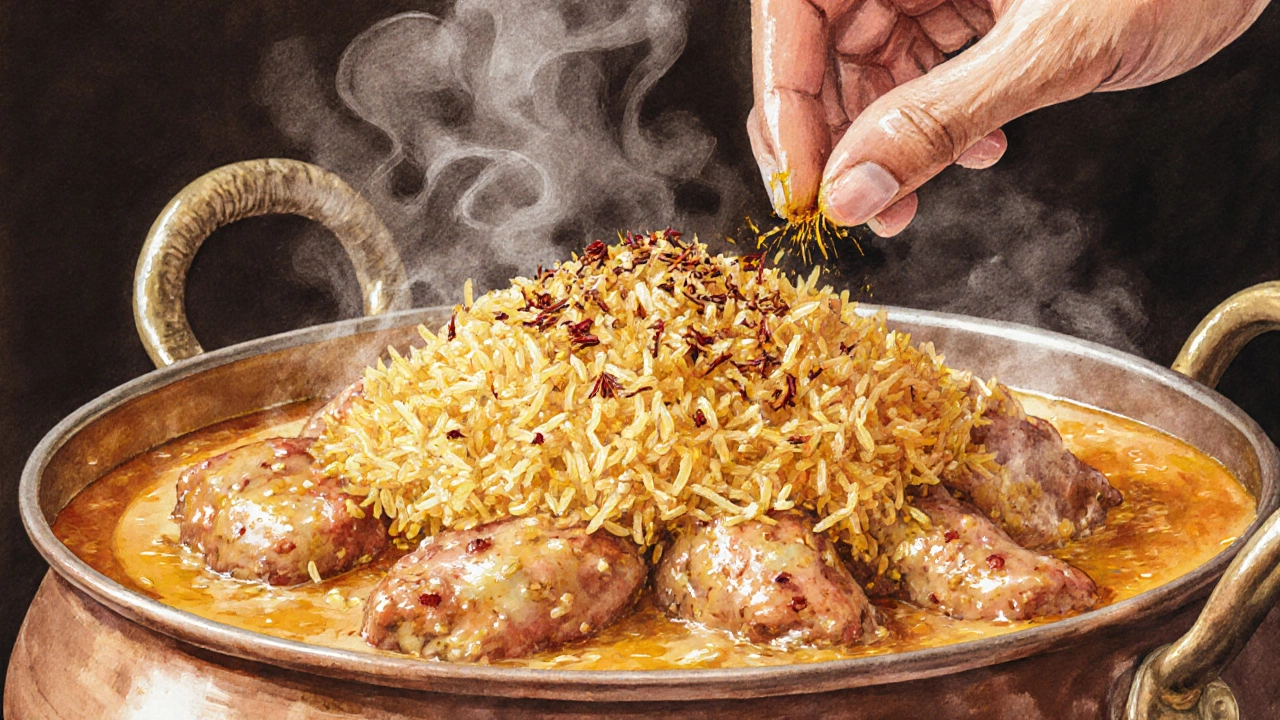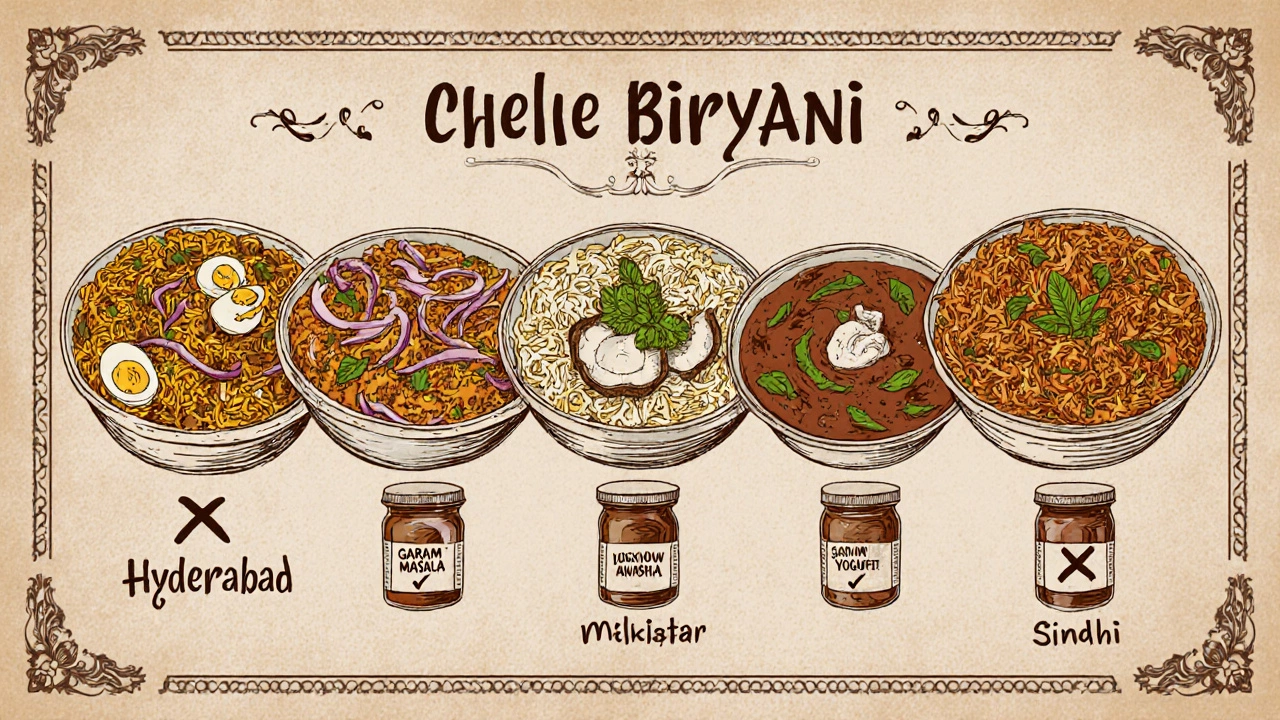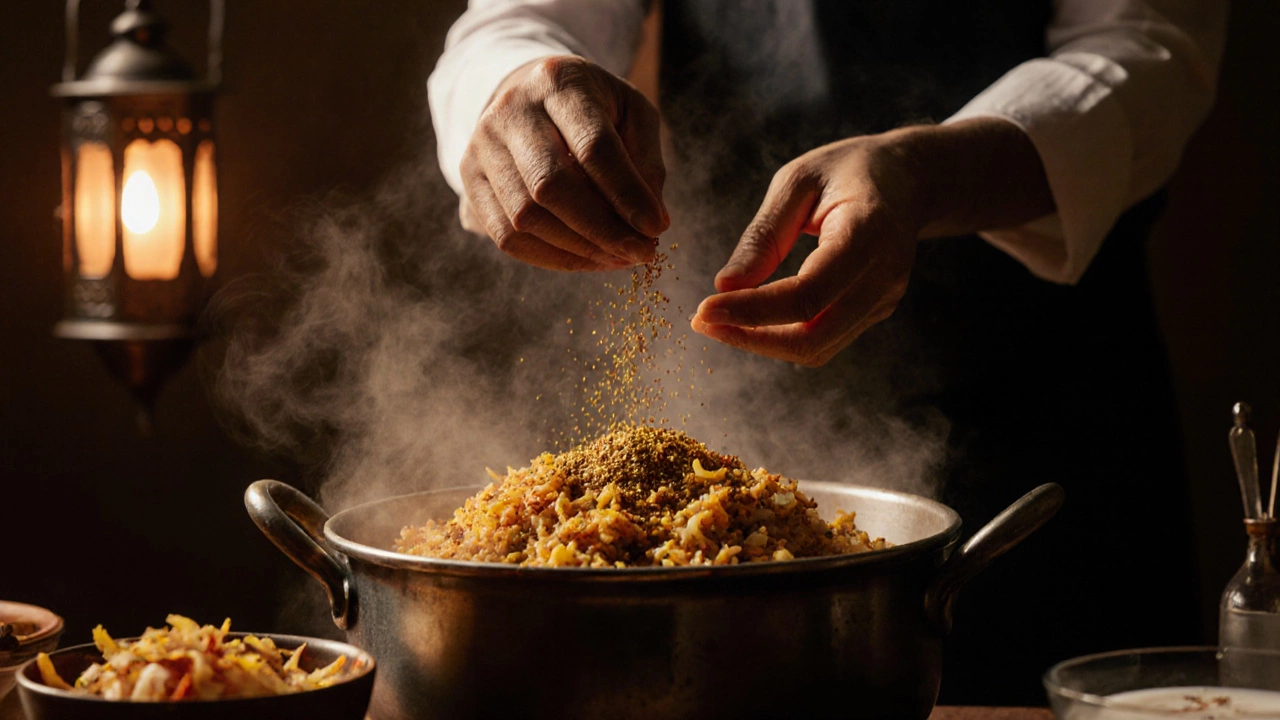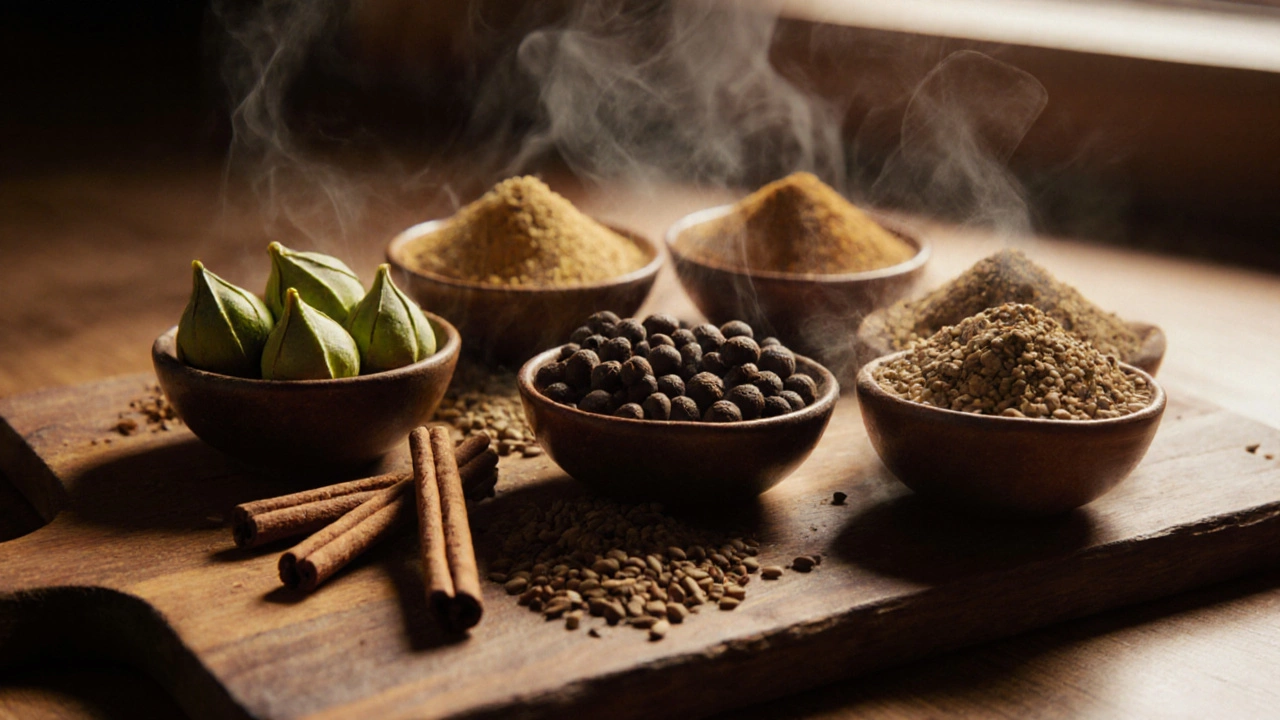Garam Masala in Biryani: Usage Guide
Select Your Biryani Style
DIY Garam Masala Recipe
Create your own garam masala blend using pantry staples:
- 2 parts ground cumin
- 2 parts ground coriander
- 1 part ground black pepper
- 1 part ground cardamom
- 1 part ground cinnamon
- 1 part ground cloves
Toast each spice separately for 20-30 seconds before grinding.
Recommended Approach
Select a region and cooking stage to see the recommended garam masala usage.
Pro Tips
- Toast garam masala before use to awaken its oils
- Avoid adding it too early to preserve fragrance
- Store homemade blends in airtight containers away from light
- Use fresh spices for best aroma and flavor
Quick Takeaways
- Garam masala is not a mandatory ingredient in every biryani, but it adds a distinct warmth.
- Traditional Hyderabadi biryani uses garam masala in the final layering, while Lucknowi (Awadhi) biryani often omits it.
- Key spices that make up garam masala - cardamom, cinnamon, cloves, cumin, coriander, black pepper - already appear elsewhere in the dish.
- Adding garam masala too early can mute its fragrance; best added at the end of cooking or as a garnish.
- If you run out of garam masala, a quick homemade mix or a pinch of each individual spice works fine.
When talking about Indian cooking, Garam Masala is a warm, aromatic blend of ground spices typically including cardamom, cinnamon, cloves, cumin, coriander, and black pepper. It’s the spice‑mix that many think of as the final "kick" in a curry or stew. But is it used in biryani a layered rice dish that combines basmati rice, meat or vegetables, and a tapestry of spices? The short answer: sometimes, but not always. The answer depends on the regional style, the chef’s preference, and the point in the cooking process where the flavor burst is desired.
What Exactly Is Garam Masala?
Garam masala translates to "hot spice blend" - "hot" referring to its warming qualities, not necessarily its heat level. A classic North‑Indian blend includes:
- Cardamom (sweet, floral notes)
- Cinnamon (sweet, woody aroma)
- Cloves (intense, slightly bitter flavor)
- Cumin (earthy, nutty undertone)
- Coriander seeds (citrusy, mild sweetness)
- Black pepper (sharp, pungent bite)
Regional recipes tweak the blend - some add nutmeg, star anise, bay leaf, or dried ginger. Because each kitchen can create its own version, the exact aroma of garam masala varies widely.

Traditional Role of Garam Masala in Biryani
In many classic biryani recipes, garam masala is introduced during the final stages of cooking. The rationale is simple: most of the spices in a biryani-cumin, coriander, turmeric, chili powder-are cooked early, allowing their flavors to meld with the meat or vegetables. Garam masala, with its delicate volatile oils, loses potency if simmered for too long. Adding it at the very end preserves that fragrant snap.
For example, a Hyderabadi chicken biryani often calls for a tablespoon of garam masala sprinkled over the top layer of rice just before the pot is sealed for the final "dum" (steam) phase. The steam lifts the aroma, letting it permeate the rice without being over‑cooked.
Conversely, the Lucknowi (Awadhi) biryani, which relies heavily on a milder, buttery flavor profile achieved through a slow “pakka” cooking method, typically omits garam masala altogether. The richness comes from ghee, saffron‑infused milk, and a delicate balance of whole spices that are toasted and ground fresh.
These regional preferences explain why you’ll find recipes that both include and exclude garam masala. The key takeaway is that the spice blend is a tool for depth, not a strict requirement.
Regional Biryani Variations and Their Spice Strategies
| Region | Typical Garam Masala Use | Key Complementary Spices | Flavor Focus |
|---|---|---|---|
| Hyderabad | Added in the final layering, often 1-2 tbsp | Cumin, coriander, turmeric, red chili powder | Robust, spicy, aromatic |
| Lucknow (Awadhi) | Usually omitted | Cardamom pods, bay leaf, cloves, nutmeg | Subtle, buttery, fragrant |
| Kolkata | Mixed into the meat marination, moderate amount | Potatoes, boiled eggs, mustard oil | Rich, slightly sweet, tangy |
| Malabar (Kerala) | Added with the rice, light sprinkle | Curry leaves, fennel seeds, coconut oil | Coconut‑infused, mildly spicy |
| Pakistani Sindhi | Stirred into the gravy before layering | Yogurt, mint, green chilies | Tangy, fresh, hearty |
Notice how each style balances garam masala with other aromatics. If you’re adapting a recipe, look at the region it originates from - that will tell you whether to use, skip, or tweak the amount.

When & How to Add Garam Masala for Maximum Impact
- Prepare the blend. If you’re using store‑bought garam masala, give it a quick toast in a dry pan for 30 seconds. This awakens the oils.
- Finish the meat or veg. After the primary cooking stage (usually when the meat is almost tender), sprinkle the toasted garam masala over the pot.
- Layer the rice. When you place the partially cooked basmati on top, gently drizzle a little melted ghee and sprinkle a second half of the garam masala.
- Seal & steam (dum). Cover the pot with a tight‑fitting lid, seal with dough or foil, and let it steam on low heat for 20-25 minutes. The enclosed steam carries the aromatic molecules throughout the dish.
- Garnish before serving. A final pinch of fresh garam masala, plus a few fried onions, boosts the visual and aromatic cue.
Why these steps? Garam masala’s volatile compounds evaporate quickly. Adding it too early-say, with the onions at the start-means most of its perfume disappears before the rice even meets the meat. The timing above captures the scent right before the final steam.
Common Mistakes & Pro Tips
- Over‑spicing. Because the blend already contains strong spices, using more than the recipe calls for can overwhelm the subtle saffron and rose water notes.
- Using stale garam masala. Ground spices lose potency after six months. Store your blend in an airtight jar, away from sunlight, and replace it yearly.
- Skipping the toast. Untoasted garam masala can taste flat. A quick dry‑roast releases the essential oils without adding oil.
- Mixing with wet ingredients early. Adding it to the yogurt‑marinade, for instance, dilutes the flavor. If you must incorporate it into a marinade, keep the quantity to a quarter of the final amount and add the rest later.
- Confusing garam masala with curry powder. Curry powder has turmeric as a base and is milder. For authentic biryani, stick with garam masala.

Substitutes & DIY Garam Masala
If you run out of the ready‑made mix, you can assemble a quick version using pantry staples. Here’s a reliable ratio that mirrors a classic North‑Indian blend:
- 2 parts ground cumin
- 2 parts ground coriander
- 1 part ground black pepper
- 1 part ground cardamom
- 1 part ground cinnamon
- 1 part ground cloves
Toast each spice separately for 20‑30 seconds, then grind them together. The result won’t be identical to a shop‑bought blend (which often uses whole spices for deeper flavor), but it works well in a pinch.
Other regional alternatives include:
- Punjabi masala. Adds fenugreek and mustard seeds for a slightly bitter edge.
- Ras el hanout (North African). A complex blend that can lend an exotic twist to a chicken biryani.
Putting It All Together: Sample Hyderabadi Chicken Biryani
- Marinate 1kg chicken pieces with 200g yogurt, 2tbsp ginger‑garlic paste, 1tsp turmeric, 1tsp red chili powder, and ½tsp salt for 2hours.
- Heat 4tbsp ghee, add 2 bay leaves, 4 green cardamom pods, 4 cloves, 1inch cinnamon stick; toast 30seconds.
- Add sliced onions, fry until golden brown. Set aside half for garnish.
- Stir in the marinated chicken, cook until 70% done.
- Prepare 500g basmati rice: rinse, soak 30minutes, then par‑boil with 1tsp salt and a few whole spices (cumin, cardamom).
- Layer the partially cooked rice over the chicken, drizzle 2tbsp ghee, sprinkle 2tbsp toasted garam masala, a pinch of saffron‑infused milk, and the reserved fried onions.
- Seal the pot with dough, place a heavy weight on top, and let it dum on low heat for 25minutes.
- Serve hot, accompanied by raita and salad.
This recipe showcases the classic timing of garam masala - added right before the final steam, giving the dish that signature heady aroma. Feel free to experiment: a lighter hand with garam masala works for a more subtle biryani, while a generous sprinkle satisfies those who love a bold spice punch.
Frequently Asked Questions
Do I have to use garam masala in every biryani?
No. Some regional styles, like Lucknowi (Awadhi) biryani, traditionally skip garam masala. It’s a flavor enhancer, not a mandatory base.
Can I add garam masala at the beginning of cooking?
You can, but the volatile oils will evaporate, leaving a muted aroma. Most cooks prefer adding it towards the end or as a garnish to keep its fragrance alive.
What’s the difference between garam masala and curry powder?
Curry powder usually contains turmeric as a base and has a milder, earthier profile. Garam masala focuses on warming spices like cardamom, cinnamon, and cloves, and is used for a finishing aromatic burst.
How long does homemade garam masala stay fresh?
Stored in an airtight container away from light, a homemade blend retains its potency for about 6months. After that, the flavors start to fade.
Can I substitute garam masala with a different spice blend?
Yes. A quick blend of toasted cumin, coriander, black pepper, and a pinch of ground cardamom mimics the core notes. For an exotic twist, try a small amount of Ras el hanout.
